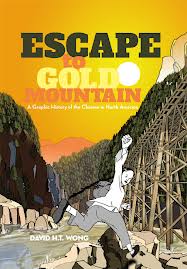Escape to Gold Mountain
By David H.T. Wong
Arsenal Pulp Press, 239 pages, $19.95
Reviewed by Andrea Routley
Many readers are probably familiar with some of the history of Chinese settlers in North America. Maybe they think of racist policies like the Chinese Head Tax, or the Chinese Immigration Act in Canada, which effectively banned all Chinese immigration for a quarter of a century. In Escape to Gold Mountain, David H.T. Wong tells this story through a narrative which spans generations of one family, from an aging father in 19th century Qing Dynasty China, the Opium wars, the construction of the Transcontinental railroad in the USA and the CPR in Canada, violent oppression including a massacre of Chinese miners in Wyoming, lynchings in San Francisco, through to the pioneering achievements of Chinese-Canadians and Americans in government, political activism and more. Sound like a big story? It is.
Although a fictional graphic novel, Escape to Gold Mountain is based on historical fact, and on Wong’s own family history. The character readers follow most is Wong Ah Gin, who endures a barrage of predicaments and situational conflicts. We gleam only a little insight into his personality through his relationship with an adopted son, but we must soon leave him behind. Maybe this reflects all histories: the way we touch here softly for a short time, then die, another faint stroke on the past, faint memory for the future. But this may disappoint readers looking to become emotionally invested in the life of one character. Indeed, as the novel progresses and the family tree expands, it is hard to keep up with who is who.
Still, Wong’s drawings do much of the work of individuating characters. The illustrations have a dynamic cinematic quality, with variation in the layout and dimensions of frames, close-ups and aerial views that reflect the scope of the story and the pace of change.
Of course, any story spanning these historical events would be the stuff of an epic novel, but I love this form—the graphic novel—for the way it reconstructs a pictorial history. There is a shortage of images from this time—how many photos have we seen of Chinese workers blasting the side of a mountain, or working at saw mills in places like Port Alberni? And to follow so many generations, each confronted with yet another kind of legislated hate or violent backlash, is exhausting. Even in reading this dynamic graphic narrative I thought, “Not another tax increase!” or “Not another attack!” as if the story were becoming repetitive. But that is exactly the point, of course. Even from my comfy spot on my couch with my coffee and decades (not to mention cultural heritage) between myself and many of these events , I am exhausted by them, a frank reminder of the persistence and endurance necessary for early Chinese Canadians to live in Canada.
I admit I have a soft spot for the historical graphic narratives. In high school, I was a big fan of shoplifting books like Nietzche for Beginners, Fascism for Beginners, or Maus. I can still picture Wagner and Nietzche on the same page, Wagner with his wild hair and “Humph!” expression on his face, having their man-crush fall-out. Okay, so maybe I missed some of the bigger picture. But any book that can make a teenager steal for History is doing something pretty remarkable. If I were 17 again, I might have stolen Escape to Gold Mountain, too.
(Don’t worry, I paid for it.)
Andrea Routley is a writer and musician based in Victoria, BC.
